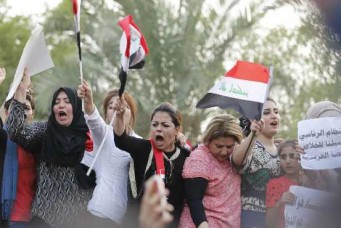Abadi’s Failed Reforms
Abadi’s reforms have been mischaracterized both in terms of their content and the reasons driving opposition to them.
The Iraqi parliament voted on November 2 to revoke any mandate for Prime Minister Haider Al-Abadi to conduct reforms, putting an end to an eleven-week period in which the weak head of government seemed to ride a popular wave. The short era of “Al-Abadi’s reforms”—from when he issued his first statement of reform measures on August 9—has often been mischaracterized both in terms of what Al-Abadi was doing and the reasons driving opposition to him. Both had less to do with fighting corruption than a more conventional power struggle, and his failure to enact reforms thus far has been due not only to Shia rivals’ efforts to undermine him but also his own missteps.
All of “Al-Abadi’s reforms,” to the extent there were specific, implementable measures, were either austerity measures, such as eliminating excess government positions, or symbolic moves, such as eliminating the three vice-presidency positions, one of them held by former Prime Minister Nouri Al-Maliki. The austerity measures are indeed necessary, as the country faces a cash crisis amid low oil prices, but they would not have transformed the political system. Al-Abadi neither implemented nor even proposed measures aimed at bridging the Shia–Sunni divide, fighting the war against the Islamic State more effectively, or fighting corruption—despite Western media impressions to the contrary.
Three factors helped set the stage for the November 2 parliamentary vote, which declared that he was only to enact reforms in agreement with other political actors in parliament. The first was the fact that he had genuinely overstepped his constitutional bounds. The constitution requires that the president have at least one vice president, and the 2011 law that provides a legal framework for the appointment and removal of vice presidents gives the prime minister no role in this. Likewise, on August 16 Al-Abadi issued an executive decree merging ministries and dismissing some ministers, something only parliament is empowered to do. An August 11 parliament vote endorsed Abadi’s original August 9 measures, but some of them—especially the abolition of the vice presidencies—were arguably unconstitutional, and parliament did not endorse any of his subsequent measures.
The lack of support for Al-Abadi’s reforms among his Shia rivals was based on the fear that he is attempting to establish an alternative political platform that could marginalize militia parties, not opposition to any purported radical reform effort, as some media have inaccurately suggested. The lack of support was also certainly not related in any way to a broad-based effort to fight corruption. Al-Abadi himself played down expectations of prosecuting senior figures, emphasizing the elimination of “waste” (hadr), rather than “theft” (sariqa), as the main goal of reform. His only anti-corruption measures were the creation of two committees, one on transparency that Al-Abadi would head himself (announced on August 9 and not heard from since) and the second to examine political parties’ use of public property. He left Hassan Al-Yasseri, a loyalist of his own Dawa Party, in place as head of the Integrity Commission, which is the institution charged with bringing anti-corruption prosecutions. And indeed none of the targets of investigations and prosecutions announced since August are well-connected to the major blocs, either Shia or Sunni.
Beyond personal ambitions, security and foreign policy also divide Al-Abadi and his Shia rivals. Al-Abadi is focused on rebuilding the national army and developing close ties to Western countries while the Iran-aligned factions are focused on building the power of Shia militia networks and tying Baghdad to the Iran-Damascus-Moscow axis. A leaked letter to Al-Abadi from Abu Mahdi Al-Muhandis, nominally the deputy commander of the Hashd (Popular Mobilization) militia organization but in fact its real commander, highlighted this. Al-Muhandis used a lecturing tone about how “time and time again” he had told the prime minister that the Hashd deserved the infrastructure, pay, and status of the army and other security services. The letter, dated October 20, was leaked to the Iraqi press immediately, and was a direct challenge to Al-Abadi’s policy direction. This divide over foreign policy also carried over to the fight over cabinet administration. This past month Al-Abadi confirmed the previously temporary appointment of Imad Al-Kharsan, an Iraqi-American known for close ties to the U.S. government, as the cabinet chief, replacing an Al-Maliki appointee. While the cabinet chief is not a high-profile position publicly, it is a vital one bureaucratically. Figures from the Al-Maliki–Badr wing of the State of Law Coalition (SLC) made clear their displeasure in both on- and off-the-record comments to the Iraqi press.
A second element of Al-Abadi’s setback was his failure to build a political coalition, or at least a public consensus, for a reform program. Al-Abadi declared his first “set of reforms” on August 9, following large protests in Baghdad and the south and central parts of the country. While largely in Shia areas, their rhetoric was non-sectarian and focused on public interest issues, especially corruption and the lack of basic public services such as electricity. The key activists involved in the protests were ideologically secular, and by August anti-Islamist sentiment was becoming more prominent in television interviews with protest leaders. State television began using Al-Abadi’s picture and the phrase “Al-Abadi’s reforms” (islahat Al-Abadi) in the background to its news bulletins, and some protesters began chanting his name, calling on him to prosecute corrupt officials from the previous government. But within a month of Al-Abadi’s first announced reforms, protest leaders were already becoming vocal in their disappointment with him.
Al-Abadi’s necessary austerity reforms not only failed to satisfy protester demands for prosecuting officials, the measures isolated him politically. The emergence of a new reform political narrative in August, which Al-Abadi initially seemed poised to capture, also posed a major threat to the Iran-aligned political factions and militias. Former Prime Minister Nouri Al-Maliki, the Badr Organization’s Hadi Al-Ameri, and Asaib Ahl Al-Haq’s Qais Al-Khazali all criticized Al-Abadi’s reform agenda, claiming it distracts from the war against Sunni terrorists, their political mainstay. Furthermore, support for him within parliament collapsed. When Al-Abadi arrived at the parliament building for an appearance on September 10, he soon left, reportedly after being warned that Maliki allies planned to ambush him with hostile questions. It is frankly doubtful that anyone in Al-Abadi’s position could have won broad support from parliament, given its current composition, but this was a key factor leading to the November 2 vote against him.
However, Al-Abadi did have the backing of Iraq’s Shia marja‘iyya, or clerical authority, embodied in Ayatollah Ali Al-Sistani. His leading representatives gave Friday sermons during this period that both supported the protests for reforms and called for Al-Abadi to take stronger action to prosecute senior political figures involved in corruption. Despite this support from both the Shia clerical establishment and the Shia street, Al-Abadi began his reforms from a position of weakness because he was only elected over Maliki because of a split within his Dawa Party and the broader State of Law Coalition. As a result, Al-Abadi had no coalition base, and so he could only govern by consensus or by making executive appointments without parliamentary approval.
A third factor, and one entirely within his control, was the debacle of his public sector compensation reform. The cabinet approved a bill on October 13 explaining that low earners would be paid more and most higher grades be paid less, and Al-Abadi’s spokesman announced that the new salary scale would go into place immediately. Yet the government gave no clear guidance on how much salaries would be cut. Word spread that middle class professionals faced immediate cuts of up to 50 percent, and even if this was exaggerated, protests by Iraq’s large public sector professional class exploded against Al-Abadi. After two weeks of public abuse, Al-Abadi finally backed down and indicated that the reforms would be amended and delayed, but the damage was done—a new narrative of protests against “Al-Abadi’s reforms” had taken root, and this provided cover for the other parties to move against him.
This does not mean Al-Abadi will be removed from office, but only that his moment to build a public platform for reform has passed for now. The Shia and Sunni Arab parties criticizing him are on the opposite ends of the political spectrum, making a majority coalition against him impossible. But until Al-Abadi can run in an election at the head of a coalition—and win—he will have to depend on unstable issue-by-issue coalitions to get anything done.
This article is reprinted with permission of Sada. It can be accessed online here.
Kirk H. Sowell is a political risk analyst and the publisher of the biweekly newsletter Inside Iraqi Politics. On Twitter: @uticensisrisk.




